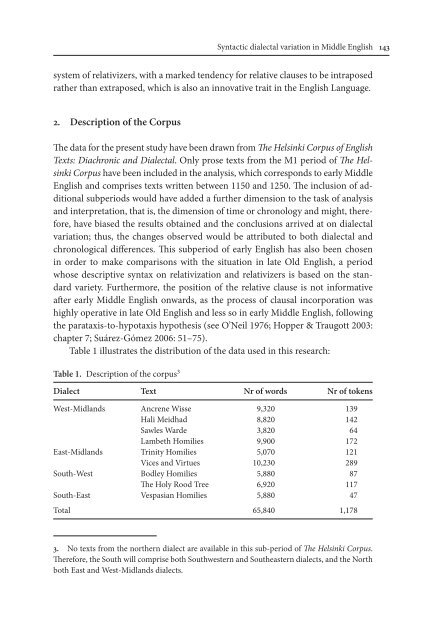Selected Papers from the Fourteenth International ... - STIBA Malang
Selected Papers from the Fourteenth International ... - STIBA Malang
Selected Papers from the Fourteenth International ... - STIBA Malang
Create successful ePaper yourself
Turn your PDF publications into a flip-book with our unique Google optimized e-Paper software.
Syntactic dialectal variation in Middle English 143<br />
system of relativizers, with a marked tendency for relative clauses to be intraposed<br />
ra<strong>the</strong>r than extraposed, which is also an innovative trait in <strong>the</strong> English Language.<br />
2. Description of <strong>the</strong> Corpus<br />
The data for <strong>the</strong> present study have been drawn <strong>from</strong> The Helsinki Corpus of English<br />
Texts: Diachronic and Dialectal. Only prose texts <strong>from</strong> <strong>the</strong> M1 period of The Helsinki<br />
Corpus have been included in <strong>the</strong> analysis, which corresponds to early Middle<br />
English and comprises texts written between 1150 and 1250. The inclusion of additional<br />
subperiods would have added a fur<strong>the</strong>r dimension to <strong>the</strong> task of analysis<br />
and interpretation, that is, <strong>the</strong> dimension of time or chronology and might, <strong>the</strong>refore,<br />
have biased <strong>the</strong> results obtained and <strong>the</strong> conclusions arrived at on dialectal<br />
variation; thus, <strong>the</strong> changes observed would be attributed to both dialectal and<br />
chronological differences. This subperiod of early English has also been chosen<br />
in order to make comparisons with <strong>the</strong> situation in late Old English, a period<br />
whose descriptive syntax on relativization and relativizers is based on <strong>the</strong> standard<br />
variety. Fur<strong>the</strong>rmore, <strong>the</strong> position of <strong>the</strong> relative clause is not informative<br />
after early Middle English onwards, as <strong>the</strong> process of clausal incorporation was<br />
highly operative in late Old English and less so in early Middle English, following<br />
<strong>the</strong> parataxis-to-hypotaxis hypo<strong>the</strong>sis (see O’Neil 1976; Hopper & Traugott 2003:<br />
chapter 7; Suárez-Gómez 2006: 51–75).<br />
Table 1 illustrates <strong>the</strong> distribution of <strong>the</strong> data used in this research:<br />
Table 1. Description of <strong>the</strong> corpus 3<br />
Dialect Text Nr of words Nr of tokens<br />
West-Midlands Ancrene Wisse 9,320 139<br />
Hali Meidhad 8,820 142<br />
Sawles Warde 3,820 64<br />
Lambeth Homilies 9,900 172<br />
East-Midlands Trinity Homilies 5,070 121<br />
Vices and Virtues 10,230 289<br />
South-West Bodley Homilies 5,880 87<br />
The Holy Rood Tree 6,920 117<br />
South-East Vespasian Homilies 5,880 47<br />
Total 65,840 1,178<br />
3. No texts <strong>from</strong> <strong>the</strong> nor<strong>the</strong>rn dialect are available in this sub-period of The Helsinki Corpus.<br />
Therefore, <strong>the</strong> South will comprise both Southwestern and Sou<strong>the</strong>astern dialects, and <strong>the</strong> North<br />
both East and West-Midlands dialects.










